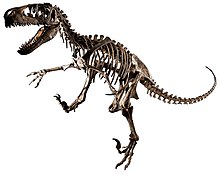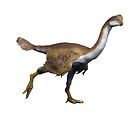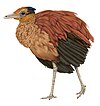猶他盜龍屬

| 犹他盗龙属 | |
|---|---|
 | |
| 於楊百翰大學古生物博物館的復原骨架 | |
| 科学分类 | |
| 界: | 动物界 Animalia |
| 门: | 脊索动物门 Chordata |
| 纲: | 蜥形纲 Sauropsida |
| 总目: | 恐龍總目 Dinosauria |
| 目: | 蜥臀目 Saurischia |
| 亚目: | 獸腳亞目 Theropoda |
| 科: | †驰龙科 Dromaeosauridae |
| 演化支: | †真驰龙类 Eudromaeosauria |
| 亚科: | †驰龙亚科 Dromaeosaurinae |
| 属: | †犹他盗龙属 Utahraptor Kirkland et al., 1993 |
| 模式種 | |
| †奧梅氏猶他盜龍 Utahraptor ostrommaysi Kirkland et al., 1993 | |
猶他盜龍(屬名:Utahraptor,意為「猶他州的盜賊」)是種二足行走的大型肉食性奔龍科獸腳類恐龍。化石出土於美國猶他州早白堊世凡藍今階(約1億3500萬至1億3000萬年前)的雪松山層。模式種兼唯一種奧梅氏猶他盜龍(U. ostrommaysi)發表於1993年,是當時已知體型數一數二大型的奔龍科,身長約5.5公尺及體重300公斤,體格結構相當粗壯。
發現及命名
[编辑]
首個猶他盜龍標本於1975年由詹森在猶他州東部格蘭德縣摩押市附近的道吞維斯採石場(Dalton Wells Quarry)所發現,但當時並沒引起太多關注。直到1991年10月李蒙(Carl Limone)發現一個大型腳趾爪之後,柯克蘭、加斯頓(Robert Gaston)、伯格(Donald Burge)隨即前往當地的加斯頓採石場(Gaston Quarry)展開挖掘,並於屬於雪松山組黃貓段(Yellow Cat Member)、毒帶段(Poison Strip Member)發現進一步的猶他盜龍化石。[1]正模標本CEUM 184v.86目前保存在東猶他學院古生館。而詹森發現的最大隻標本則保存在楊百翰大學。

模式種奧梅氏猶他盜龍(Utahraptor ostrommaysi)由柯克蘭、加斯頓、伯格於1993年6月發表。屬名意為「猶他盜賊」,取自發現地加上奔龍科常見字尾raptor。種名致敬奧斯壯對恐爪龍與其跟鳥類之關聯研究的貢獻,以及梅斯(Chris Mays)透過動態企業贊助了猶他盜龍的研究。[1]起初命名時柯克蘭等曾考慮將種名以執導《侏羅紀公園》的電影導演史蒂芬·史匹柏為名,企圖獲得財務贊助,但雙方卻未能於財務支援多寡達成共識而作罷。[2]2000年奧舍夫斯基(George Olshevsky)將原種名ostrommaysi修改為複數形態的ostrommaysorum。[3]但2019年寇斯塔(Thiago Vernaschi V. Costa)和戴維(Normand David)批評道ostrommaysorum的採用並未指出明確理由或解釋。就算之前這種拼法已被其他大量人士使用,有鑑於國際動物命名規約並未規定可以用兩種拼法表達屬格,所以他們解釋最初的ostrommaysi將僅視作字母任意組合而非正確屬格,因此無須修正而ostrommaysorum不具效力。其他文獻使用過的誤拼還有如ostromaysi、ostromaysorum、ostromayssorum、ostromayorum及ostrommaysori。[4]
描述
[编辑]


正模CEUM 184v.86是第二腳趾爪,其他可能歸入的參考標本有CEUM 184v.294(腳爪)、CEUM 184v.260(脛骨)、CEUM 184v.400(前上頜骨)。這些部位與其他奔龍科相比有著較大的比例,顯示猶他盜龍的體長約是恐爪龍的兩倍。[1]如同其他奔龍科,猶他盜龍第二腳趾長有巨大彎曲的爪子,保存的第二趾爪長22公分,估計生前長達24公分。[1]
最大隻的猶他盜龍標本(BYUVP 15465於2009年艾瑞克森等歸入[5])估計身長可達7公尺及體重少於500公斤,相當於一頭北極熊。[1]2012年湯瑪斯·霍茨估計體重介於230至450公斤,相當於棕熊。[6]但2001年柯克蘭發現的標本顯示體重可能遠高於過去所估計。[7]2016年莫里納裴雷茲(Rubén Molina-Pérez)和拉臘曼迪(Asier Larramendi)估計最大標本BYU 15465長4.65公尺、臀高1.5公尺及體重280公斤;他們表示較高的估計值是因為綜合了九個不同年齡的標本。[8]2016年葛瑞格利·保羅估計身長5.5公尺及體重最高300公斤,近似於前者。[9]
某些標本曾錯誤歸入猶他盜龍,如CEUM 184v.83的淚骨其實是甲龍類的加斯頓龍。布里特等還指出原本以為是手爪的M184v.294、BYU 9438和BYU 13068其實來自腳爪。[10]2007年得到森特證實。[11]

1993年柯克蘭提出鑑定猶他盜龍的自衍徵如下:手爪比其他奔龍科更適應切割;淚骨內外側明顯平行,俯視呈細長亞矩形;前上頜骨的鼻孔與前上頜牙排平行。[1]2012年透納等人修正了猶他盜龍與其他奔龍科的差異在於:前上頜骨加長鼻突;第三蹠骨遠端平滑非牙齦狀;方軛骨缺乏L形後突;大小轉子間的縫隙發育良好;背椎缺乏側凹。[12]
雖然猶他盜龍沒發現明確的羽毛證據,可信的分類支持所有奔龍科都覆羽。小盜龍是最古老的奔龍科之一,種系發生位置比猶他盜龍還原始;[13]因其明確的羽毛證據而使這種特徵普遍存在於奔龍科的假設合理化。有鑑於羽毛可能演化了不只一次,因此若要證實特定奔龍科(如猶他盜龍)沒有羽毛,反而也需要明確證據來支持。[14]截至今日都未曾有更大更先進奔龍科失去羽毛的任何跡象。[15]在達科塔盜龍身上發現羽莖瘤代表了更大的奔龍科也有羽毛。[16]
分類
[编辑]猶他盜龍屬於奔龍科(俗稱「盜龍」),是獸腳類虛骨龍類手盜龍類近鳥類的演化支。猶他盜龍是其中體型最大者,並與伶盜龍、恐爪龍、奔龍處於同一支系真驰龙類。[1]
2015年的研究將猶他盜龍與較小型的奔龍、蒙古巨型的阿基里斯龍、以及北美巨型的達科塔盜龍一同列入驰龙亞科。[16]

| 真驰龙類 Eudromaeosauria |
| ||||||||||||||||||||||||||||||||||||||||||

| 真驰龙類 Eudromaeosauria |
| ||||||||||||||||||||||||||||||||||||||||||||||||||||||||||||
古生物學
[编辑]
運動能力
[编辑]柯克蘭等人指出猶他盜龍因為巨大的體型,速度可能不及恐爪龍和伶盜龍,反而相當於同期的禽龍類,並快於蜥腳類。脛骨厚度則顯示猶他盜龍有強勁腿力足以殺死獵物。[1]還指出伶盜龍及恐爪龍等奔龍科靠手爪處理獵物、並在踢擊獵物時輔助平衡。與此相反,重量級猶他盜龍能踢腿又同時維持平衡,使雙手得以空出來處理獵物。[1]保羅認為猶他盜龍速度並不特別快,而可能作為一名伏擊者偷襲大型獵物,如共棲的禽龍類及鐮刀龍類。其健壯體格及巨型鐮刀爪顯示非常適於捕殺此類獵物。一如其他奔龍科,猶他盜龍也可能大幅依賴下顎捕食,程度更勝於伶盜龍。[18]
2001年羅斯柴爾德(Bruce Rothschild)檢驗兩個歸入猶他盜龍的趾骨是否存在疲勞性骨折但未發現任何跡象。[19]
社會行為
[编辑]一名研究生在猶他東部發現一個重達9噸的砂岩岩塊,其中有骨頭突出,2001年柯克蘭等人檢驗了這項發現。確認其中包含至少七隻個體,有一隻長約4.8公尺的成體、四隻年輕個體及一隻長約1公尺的幼體。與之一同形成的其他遺骸還有至少一種植食禽龍類。柯克蘭推測這是猶他盜龍群試圖襲擊陷入流沙的無助獵物或採食其腐肉,自己卻也陷入泥淖中無法脫身。克里夫蘭羅伊採石場(Cleveland-Lloyd Quarry)和加州的拉布雷亞瀝青坑都展現了類似的捕食陷阱。挖掘活動已經十年,檢驗化石工作仍持續進行;若柯克蘭所述為實,這可能是迄今所知保存最完好的捕食陷阱之一。對猶他盜龍進一步的行為理解可能從這些化石中找到各方面資訊,如猶他盜龍是否像之前所認為的恐爪龍群體捕獵一樣情況。至於這些個體是否同時陷入泥潭、抑或是分別遭殃,則尚未明瞭。[7]對岩塊進一步檢驗發現其中的猶他盜龍數量可能是先前推測的兩倍之多。[20]
儘管對恐龍行為的推測僅止於理論層面,2020年的研究發現恐爪龍可能缺乏類似某些現生掠食動物的複雜社會行為,因為成體和年輕體有不同食性偏好,代表牠們不會以家庭為單位生活。目前尚未證實如此缺乏複雜合作性的社會模式是否也可套用到猶他盜龍。[21]
古生態學
[编辑]年代
[编辑]
猶他盜龍來自雪松山層下部層位,稱為黃貓段(Yellow Cat Member)。據描述論文所述,猶他盜龍在早白堊世拱門國家公園古動物群中的主要肉食性動物生態棲位佔有重要地位,可能襲擊比自身更大的獵物。若此屬實則3.5公尺/70公斤的個體狩獵時可撂倒8公尺/1至2噸的獵物。此外20公尺左右的蜥腳類可能作為猶他盜龍的重要食物來源。[1]霍茨推測猶他盜龍生存於1億3000萬至1億2500萬年前。[6]許多情境均將黃貓段年代指向巴列姆階-阿普第階。2010年分析修正成貝里亞階-凡藍今階,但不受其他研究人員廣泛接受。[22]2019年透過先進的輻射及孢粉學測年發現黃貓段確實比過去所認為還古老,約沉積於1億3900萬±130萬至1億3460萬±170萬年前/貝里亞階-凡藍今階晚期。由於發現新種孢粉存在,臨時假定了貝里亞階中期-豪特里維階。[23]但黃貓段有明顯的上下層區分,而猶他盜龍僅出產自上層,其活躍年代約1億3500萬至1億3000萬年前。[24]
植物群
[编辑]猶他盜龍棲息的黃貓段當時是個半乾旱環境,有氾濫平原、流域森林、開放林地,主要由松柏門、蕨類、角蘚門與其他維管束植物組成。[23]在米耶拉龍的描述還提到當地有親水沼澤濕地。[25]相信雨季短暫,因為在花粉痕跡發現燒焦的孢子、碳化植物碎屑,顯示缺乏降水時期容易發生森林火災。[18][23]
動物群
[编辑]
猶他盜龍與多樣化恐龍動物相共棲,如中型禽龍類馬龍、雪松山龍、鬣蜥巨龍;其他獸腳類瑪莎盜龍、鑄鐮龍、內德科爾伯特龍、郊狼龍、雙子盜龍;結節龍科加斯頓龍;蜥腳類雪松龍、摩押龍、米耶拉龍。[25][24][26]上黃貓段唯一已知哺乳類是西菲力齒獸。[27]
除恐龍以外的其他動物有魚類角齒魚、背註魚;烏龜Trinitichelys;某種水鳥足跡;喙頭目Toxolophosaurus;未定弓鯊科。[24]
其餘古動物遺骸大多未命名或分類不明,如單一個20公分長中真鱷類頭骨;[24]一種新離龍類部分左股骨;[28]顯示早白雪松山有高多樣性的水生群落。[24]某種具背帆的禽龍類標本有大型脊椎和碎片遺骸;[29]還有某種真驰龙類的尾椎及尾巴碎片(UMNH VP 20209)。[30]
文化影響
[编辑]
1995年羅伯特·巴克的小說《赤盜》(Raptor Red)是關於一小群猶他盜龍的虛構故事,聚焦於一隻雌性。此作得到主流評論界的積極評價,但對化石證據的缺乏導致古生物學術失準持保留態度,而隨著時代演進與學界知識的更新,使某些故事情節變得過時不準確。[31][32]巴克對赤色之角色的擬人化特別受讚揚。[33][34][35]
Paul Zindel的小說《Raptor》也出現猶他盜龍,但擁有虛構的特徵,包括趾爪上的有毒分泌物,用來解釋長達6500萬年演化的副作用。
Ryan North從2003年起連載的網路數格漫畫《Dinosaur Comics》裡,猶他盜龍是一個主要角色,扮演質疑與提問的角色。漫畫在提問與回答間傳授許多恐龍的相關知識。[36]
螢幕方面,猶他盜龍於BBC的《與恐龍共舞》(Walking with Dinosaurs)及其衍生舞台劇(Walking with Dinosaurs: The Live Experience)登場,[37]當中提及猶他盜龍一些身體特徵,如可以轉向內側的手掌,劇情並錯誤讓牠們生存在歐洲獵殺禽龍為食,實際上猶他盜龍僅發現於美西。[38]2008年猶他盜龍於《侏羅紀格鬥俱樂部》(Jurassic Fight Club)登場並獵殺加斯頓龍。探索頻道2011年的《恐龍王朝》(Dinosaur Revolution)中出現兩個猶他盜龍小隊,在追捕雪松龍時彼此發生衝突,試圖獵殺雪松龍幼體但最後被成體趕跑,還落水被鱷魚吃掉。[39]
2018年猶他盜龍被提議作為猶他州的州恐龍,並得到猶他州參議院批准。[40]起初猶他盜龍將取代異特龍成為官方州化石,後來決定讓其成為該州另一象徵。[41]2021年史蒂夫·艾里亞森[42][43]成功提案將最初的猶他盜龍化石發現地成立為猶他盜龍州立公園,並得到州議會批准。[44]
延伸閱讀
[编辑]參考來源
[编辑]- ^ 1.00 1.01 1.02 1.03 1.04 1.05 1.06 1.07 1.08 1.09 Kirkland, J. I.; Burge, D.; Gaston, R. A large dromaeosaurid (Theropoda) from the Lower Cretaceous of Eastern Utah. Hunteria. 1993, 2 (10): 1–16 [2022-06-06]. (原始内容存档于2022-06-25).
- ^ Adams, Brooke. Director Loses Utahraptor Name Game. Deseret News. June 15, 1993 [April 15, 2017]. (原始内容存档于2018-11-29).
- ^ Olshevsky, G., 2000, An annotated checklist of dinosaur species by continent. Mesozoic Meanderings 3: 1-157
- ^ Costa, T. V. V.; David, N. Commentaries on different uses of the specific epithet of the large dromaeosaurid Utahraptor Kirkland et al., 1993 (Dinosauria, Theropoda). The Bulletin of Zoological Nomenclature. 2019, 76 (1): 90−96. S2CID 166691677. doi:10.21805/bzn.v76.a028.
- ^ Erickson, G. M.; Rauhut, O. W. M.; Zhou, Z.; Turner, A. H.; Inouye, B. D.; Hu, D.; Norell, M. A. Was Dinosaurian Physiology Inherited by Birds? Reconciling Slow Growth in Archaeopteryx. PLOS ONE. 2009, 4 (10): e7390. Bibcode:2009PLoSO...4.7390E. PMC 2756958
 . PMID 19816582. doi:10.1371/journal.pone.0007390
. PMID 19816582. doi:10.1371/journal.pone.0007390  .
. - ^ 6.0 6.1 Holtz, T. R.; Rey, L. V. Dinosaurs: The Most Complete, Up-to-Date Encyclopedia for Dinosaur Lovers of All Ages. Random House. 2007. Supplementary Information 2012 (页面存档备份,存于互联网档案馆) Weight Information (页面存档备份,存于互联网档案馆)
- ^ 7.0 7.1 Kirkland, J.I.; Simpson, E.L.; DeBlieux, D.D.; Madsen, S.K.; Bogner, E.; Tibert, N.E. Depositional constraints on the Lower Cretaceous stikes quarry dinosaur site: Upper yellow cat member, cedar mountain formation, Utah. PALAIOS. September 1, 2016, 31 (9): 421–439. Bibcode:2016Palai..31..421K. S2CID 132388318. doi:10.2110/palo.2016.041.
- ^ Molina-Peréz & Larramendi. Récords y curiosidades de los dinosaurios Terópodos y otros dinosauromorfos. Barcelona, Spain: Larousse. 2016: 275. ISBN 9780565094973.
- ^ Paul, Gregory S. The Princeton Field Guide to Dinosaurs 2nd Edition. Princeton University Press. 2016: 151.
- ^ Britt, B. B.; Chure, D. J.; Stadtman, K. L.; Madsen, J. H.; Scheetz, R. D.; Burge, D. L. New osteological data and the affinities of Utahraptor from the Cedar Mountain Fm. (Early Cretaceous) of Utah. Journal of Vertebrate Paleontology. 2001, 21 (3): 36A.
- ^ Senter, P. A method for distinguishing dromaeosaurid manual unguals from pedal "sickle claws". Bulletin of the Gunma Museum of Natural History. 2007, (11): 1–6. ISSN 1342-4092.
- ^ Turner, A. H.; Makovicky, P. J.; Norell, M. A. A Review of Dromaeosaurid Systematics and Paravian Phylogeny. Bulletin of the American Museum of Natural History. 2012, 371 (371): 1–206 [2022-06-06]. S2CID 83572446. doi:10.1206/748.1. hdl:2246/6352. (原始内容存档于2022-01-03).
- ^ Xu, X.; Zhou, Z.; Wang, X.; Kuang, X.; Zhang, F.; Du, X. Four-winged dinosaurs from China. Nature. 2003, 421 (6921): 335–340. Bibcode:2003Natur.421..335X. PMID 12540892. S2CID 1160118. doi:10.1038/nature01342.
- ^ Prum, R.; Brush, A.H. The evolutionary origin and diversification of feathers. The Quarterly Review of Biology. 2002, 77 (3): 261–295. PMID 12365352. S2CID 6344830. doi:10.1086/341993.
- ^ Turner, AH; Makovicky, PJ; Norell, MA. Feather quill knobs in the dinosaur Velociraptor. Science. 2007, 317 (5845): 1721. Bibcode:2007Sci...317.1721T. PMID 17885130. doi:10.1126/science.1145076
 .
. - ^ 16.0 16.1 DePalma, Robert A.; Burnham, David A.; Martin, Larry D.; Larson, Peter L.; Bakker, Robert T. The first giant raptor (Theropoda: Dromaeosauridae) from the Hell Creek Formation. Paleontological Contributions. October 30, 2015. doi:10.17161/paleo.1808.18764
 . hdl:1808/18764.
. hdl:1808/18764. - ^ Cau, Andrea; Beyrand, Vincent; Voeten, Dennis F. A. E.; Fernandez, Vincent; Tafforeau, Paul; Stein, Koen; Barsbold, Rinchen; Tsogtbaatar, Khishigjav; Currie, Philip J.; Godefroit, Pascal. Synchrotron scanning reveals amphibious ecomorphology in a new clade of bird-like dinosaurs. Nature. December 6, 2017, 552 (7685): 395–399. Bibcode:2017Natur.552..395C. PMID 29211712. S2CID 4471941. doi:10.1038/nature24679.
- ^ 18.0 18.1 Paul, Gregory S. The Princeton Field Guide to Dinosaurs 2nd. Princeton, New Jersey: Princeton University Press. 2016: 151. ISBN 9780691167664.
- ^ Rothschild, B.; Tanke, D.; Ford, T. Theropod stress fractures and tendon avulsions as a clue to activity. Mesozoic Vertebrate Life. Indiana University Press. 2001: 331–336.
- ^ Williams, Carter. Several more Utahraptor fossils discovered from 136M-year-old block 1st found in Utah. KSL.com (Deseret Digital Media). February 25, 2021. (原始内容存档于February 27, 2021).
- ^ Frederickson, J. A.; Engel, M. H.; Cifelli, R. L. Ontogenetic dietary shifts in Deinonychus antirrhopus (Theropoda; Dromaeosauridae): Insights into the ecology and social behavior of raptorial dinosaurs through stable isotope analysis. Palaeogeography, Palaeoclimatology, Palaeoecology. May 3, 2020, 552: 109780. Bibcode:2020PPP...552j9780F. S2CID 219059665. doi:10.1016/j.palaeo.2020.109780.
- ^ Sames, B. C.; Schudack, M. E. The nonmarine Lower Cretaceous of the North American Western Interior foreland basin: new biostratigraphic results from ostracod correlations and early mammals, and their implications for paleontology and geology of the basin – an overview. Earth-Science Reviews. 2010, 101 (3–4): 207–224. Bibcode:2010ESRv..101..207S. doi:10.1016/j.earscirev.2010.05.001.
- ^ 23.0 23.1 23.2 Joeckel, R. M.; Ludvigson, G.; Moeller, A.; Hotton, C. L.; Suarez, M. B.; Suarez, C. A.; Sames, B.; Kirkland, J. I.; Hendrix, B. Chronostratigraphy and Terrestrial Palaeoclimatology of Berriasian–Hauterivian Strata of the Cedar Mountain Formation, Utah, USA. Geological Society London, Special Publications. 2019, 498: 75–100. S2CID 210296827. doi:10.1144/SP498-2018-133.
- ^ 24.0 24.1 24.2 24.3 24.4 Kirkland, J.I. The Lower Cretaceous in East-Central Utah—The Cedar Mountain Formation and its Bounding Strata. Geology of the Intermoutain West. December 1, 2016, 3: 1–130.
- ^ 25.0 25.1 Royo-Torres, R.; Upchurch, P.; Kirkland, J.I.; DeBlieux, D.D.; Foster, J.R.; Cobos, A.; Alcalá, L. Descendants of the Jurassic turiasaurs from Iberia found refuge in the Early Cretaceous of western USA. Scientific Reports. 2017, 7 (1): 14311. Bibcode:2017NatSR...714311R. PMC 5662694
 . PMID 29085006. doi:10.1038/s41598-017-14677-2.
. PMID 29085006. doi:10.1038/s41598-017-14677-2. - ^ Britt, B.B.; Scheetz, R.D.; Whiting, M.F.; Wilhite, D.R. Moabosaurus utahensis, n. gen., n. sp., A New Sauropod From The Early Cretaceous (Aptian) of North America (PDF). Contributions from the Museum of Paleontology, University of Michigan. 2017, 32 (11): 189–243. S2CID 50350241. (原始内容 (PDF)存档于2019-03-05).
- ^ Huttenlocker, Adam K.; Grossnickle, David M.; Kirkland, James I.; Schultz, Julia A.; Luo, Zhe-Xi. Late-surviving stem mammal links the lowermost Cretaceous of North America and Gondwana. Nature. May 23, 2018, 558 (7708): 108–112. Bibcode:2018Natur.558..108H. PMID 29795343. S2CID 43921185. doi:10.1038/s41586-018-0126-y.
- ^ Britt, Brooks B.; Scheetz, Rodney D.; Brinkman, Donald B.; Eberth, David A. A Barremian neochoristodere from the Cedar Mountain Formation, Utah, U.S.A.. Journal of Vertebrate Paleontology. December 11, 2006, 26 (4): 1005–1008. doi:10.1671/0272-4634(2006)26[1005:ABNFTC]2.0.CO;2.
- ^ Scheetz, R. A.; Britt, B. B.; Higgerson, J. A large, tall-spined iguanodontid dinosaur from the Early Cretaceous (Early Albian) basal Cedar Mountain Formation of Utah. Journal of Vertebrate Paleontology. 2010, 30 (Supplement 2): 158A. S2CID 220429286. doi:10.1080/02724634.2010.10411819.
- ^ Senter, P.; Kirkland, J. I.; Deblieux, D. D.; Madsen, S.; Toth, N. Dodson, Peter , 编. New Dromaeosaurids (Dinosauria: Theropoda) from the Lower Cretaceous of Utah, and the Evolution of the Dromaeosaurid Tail. PLOS ONE. 2012, 7 (5): e36790. Bibcode:2012PLoSO...736790S. PMC 3352940
 . PMID 22615813. doi:10.1371/journal.pone.0036790
. PMID 22615813. doi:10.1371/journal.pone.0036790  .
. - ^ Holtz, Thomas R. Raptor Red: a review (long). Archives of the DINOSAUR Mailing List. September 12, 1995 [December 5, 2014]. (原始内容存档于2021-03-03).
- ^ Kanipe, Jeff. Dino Redux. Earth. February 1996, 5 (1): 66–68.
- ^ Naughton, John. At home with a Jurassic monster. The Times. September 5, 1995.
- ^ Chander, David. In his field, Robert Bakker walks alone. Boston Globe. November 13, 1995: 29.
- ^ Johnson, Eric. Book Reviews: Fiction. Library Journal. September 1995, 120 (14): 205.
- ^ Whaley, K. (2006). "Tall Poppy Interview: Ryan North of Dinosaur Comics (页面存档备份,存于互联网档案馆)." The Torontoist, 17 May 2006. accessed online 16 Sep 2010, http://torontoist.com/2006/05/tall_poppy_inte_31.php (页面存档备份,存于互联网档案馆).
- ^ "Unnatural history? Deconstructing the Walking with Dinosaurs phenomenon." Media Culture & Society, 25(3): 315-332. doi:10.1177/0163443703025003002
- ^ Haines, T. (2000). Walking with Dinosaurs: A Natural History. London: BBC Publishing.
- ^ Dinosaur Revolution Episode Guide. Discovery Channel. [September 15, 2011]. (原始内容存档于2011年9月26日).
- ^ Nicole Nixon. Senate Gives Utahraptor A Roar Of Approval. February 12, 2018 [February 13, 2018]. (原始内容存档于2020-08-19).
- ^ Lisa Riley Roche. Senate approves bill making Utahraptor state dinosaur. Deseret News. February 12, 2018 [February 18, 2018]. (原始内容存档于2018-06-14).
- ^ Eliason and Iwamoto, Steve and Jani. H.B. 322 - Utahraptor State Park. Utah State Legislature. 2020 [2022-06-06]. (原始内容存档于2022-06-09).
- ^ McKellar, Katie. Utahraptor State Park would protect discovery site of Utah's namesake dinosaur. Deseret News. February 18, 2020 [2022-06-06]. (原始内容存档于2022-06-18).
- ^ Utah Considers State Park Named For Utahraptor Dinosaur. NPR.org. [2021-03-04]. (原始内容存档于2022-06-14) (英语).






















